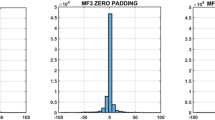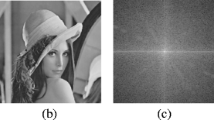Abstract
Image forgery detection is a challenging issue because fake images can be prepared accurately using precise editing tools. In this paper, a robust image forensics technique based on a multi-direction threshold (MDT) is proposed to detect median filtering. In the proposed method, an optimal thresholded array is derived from difference arrays in multiple directions. The Markov process is applied to fetch the joint probability statistics of neighboring pixels on optimally thresholded difference arrays. The proposed optimal MDT utilizes both first and second-order difference arrays for additional information that leads to a more comprehensive feature set. As a result, the proposed technique achieves 93.40%, 90.59%, and 85.76% detection accuracy on JPEG compressed images of size 64 × 64 pixels with quality factors 70, 50, and 30, correspondingly. The non-filtered and median filtered images are classified using LDA and SVM classifiers. The superiority of the proposed technique is analyzed through exhaustive experimental analysis on centrally cropped and zero-padded median filtered images.







Similar content being viewed by others
Data availability
Data sharing not applicable to this article as no datasets were generated or analyzed during the current study.
References
Agarwal S, Chand S, Skarbnik N (2016) SPAM revisited for median filtering detection using higher-order difference. Secur Commun Netw 9(17):4089–4102. https://doi.org/10.1002/sec.1590
Bas P, Furon T (2008) Break our watermarking system. Available https://bows2.ec-lille.fr/2nd. Accessed 29 May 2020
Bas P, Filler T, Pevný T (2011) Break our steganographic system: the Ins and Outs of organizing BOSS. Lect Notes Comput Sci (including subseries Lecture Notes in Artificial Intelligence and Lecture Notes in Bioinformatics) 6958 LNCS:59–70
Cao G, Zhao Y, Ni R, Li X (2014) Contrast enhancement-based forensics in digital images. IEEE Trans Inf Forensic Secur 9(3):515–525. https://doi.org/10.1109/TIFS.2014.2300937
Chaira T (2012) A rank ordered filter for medical image edge enhancement and detection using intuitionistic fuzzy set. Appl Soft Comput J 12(4):1259–1266. https://doi.org/10.1016/j.asoc.2011.12.011
Chen C, Ni J, Huang J (2013) Blind detection of median filtering in digital images: a difference domain based approach. IEEE Trans Image Process 22(12):4699–4710. https://doi.org/10.1109/TIP.2013.2277814
Chen J, Kang X, Liu Y, Wang ZJ (2015) Median filtering forensics based on convolutional neural networks. IEEE Signal Process Lett 22(11):1849–1853. https://doi.org/10.1109/LSP.2015.2438008
Colreavy-Donnelly S, Caraffini F, Kuhn S, Gongora M, Florez-Lozano J, Parra C (2020) “Shallow buried improvised explosive device detection via convolutional neural networks,” Integr Comput Aided Eng, vol. 27, no. 4, https://doi.org/10.3233/ICA-200638.
De Rosa A, Fontani M, Massai M, Piva A, Barni M (2015) Second-order statistics analysis to cope with contrast enhancement counter-forensics. IEEE Signal Process Lett. https://doi.org/10.1109/LSP.2015.2389241
Gloe T, Böhme R (2010) The Dresden image database for benchmarking digital image forensics. J Digit Forensic Pract 3(2–4):150–159. https://doi.org/10.1080/15567281.2010.531500
Gupta A, Singhal D (2019) A simplistic global median filtering forensics based on frequency domain analysis of image residuals. ACM Trans Multimed Comput Commun Appl 15(3). https://doi.org/10.1145/3321508
Halima I, Laferté JM, Cormier G, Fougères AJ, Dillenseger JL (2020) Depth and thermal information fusion for head tracking using particle filter in a fall detection context. Integr Comput Aided Eng 27(2). https://doi.org/10.3233/ICA-190615
Images corpus of the 1st IEEE IFS-TC image forensics challenge (n.d.) Available at: http://ifc.recod.ic.unicamp.br/fc.website/index.py?sec=5. Accessed 29 May 2020
Kang X, Stamm MC, Peng A, Liu KJR (2013) Robust median filtering forensics using an autoregressive model. IEEE Trans Inf Forensics Secur 8(9):1456–1468. https://doi.org/10.1109/TIFS.2013.2273394
Kirchner M, Fridrich J (2010) On detection of median filtering in digital images. Media Forensic Secur II 7541:754110. https://doi.org/10.1117/12.839100
Li SP, Han Z, Chen YZ, Fu B, Lu C, Yao X (2010) Resampling forgery detection in JPEG-compressed images. Proc. - 2010 3rd Int. Congr. Image Signal Process. CISP 2010, vol. 3, pp 1166–1170. https://doi.org/10.1109/CISP.2010.5646732
Li W, Ni R, Li X, Zhao Y (2019) Robust median filtering detection based on the difference of frequency residuals. Multimed Tools Appl 78(7):8363–8381. https://doi.org/10.1007/s11042-018-6831-6
Lien CC, Shih CL, Chou CH (2010) “Fast forgery detection with the intrinsic resampling properties,” Proc. - 2010 6th Int. Conf. Intell. Inf. Hiding Multimed. Signal Process. IIHMSP 2010, pp. 232–235, https://doi.org/10.1109/IIHMSP.2010.65.
Liu A, Zhao Z, Zhang C, Su Y (2017) Median filtering forensics in digital images based on frequency-domain features. Multimed Tools Appl 76(21):22119–22132. https://doi.org/10.1007/s11042-017-4845-0
Liu L et al (2020) Deep learning for generic object detection: a survey. Int J Comput Vis 128(2). https://doi.org/10.1007/s11263-019-01247-4
Luo S, Peng A, Zeng H, Kang X, Liu L (2019) Deep residual learning using data augmentation for median filtering forensics of digital images. IEEE Access 7:80614–80621. https://doi.org/10.1109/ACCESS.2019.2923000
Peng A, Luo S, Zeng H, Wu Y (2019) Median filtering forensics using multiple models in residual domain. IEEE Access 7:28525–28538. https://doi.org/10.1109/ACCESS.2019.2897761
Quan Q, He F, Li H (2021) A multi-phase blending method with incremental intensity for training detection networks. Vis Comput 37(2). https://doi.org/10.1007/s00371-020-01796-7
Qureshi MA, Deriche M (2015) A bibliography of pixel-based blind image forgery detection techniques. Signal Process Image Commun 39:46–74. https://doi.org/10.1016/j.image.2015.08.008
Rhee KH (2019) Forensic detection using bit-Planes slicing of median filtering image. IEEE Access 7:92586–92597. https://doi.org/10.1109/ACCESS.2019.2927540
Rhee KH (2019) Improvement feature vector: autoregressive model of median filter residual. IEEE Access 7:77524–77540. https://doi.org/10.1109/ACCESS.2019.2921573
Rhee KH (2020) Composition of visual feature vector pattern for deep learning in image forensics. IEEE Access 8:188970–188980. https://doi.org/10.1109/ACCESS.2020.3029087
Schaefer G, Stich M (2003) UCID: an uncompressed color image database. Storage Retriev Methods Appl Multimed 2004 5307:472–480. https://doi.org/10.1117/12.525375
Shan W, Yi Y, Qiu J, Yin A (2019) Robust median filtering forensics using image Deblocking and filtered residual fusion. IEEE Access 7:17174–17183. https://doi.org/10.1109/ACCESS.2019.2894981
Tang H, Ni R, Zhao Y, Li X (2018) Median filtering detection of small-size image based on CNN. J Vis Commun Image Represent 51(January):162–168. https://doi.org/10.1016/j.jvcir.2018.01.011
Yang J, Ren H, Zhu G, Huang J, Shi Y-Q (2018) Detecting median filtering via two-dimensional AR models of multiple filtered residuals. Multimed Tools Appl 77(7):7931–7953. https://doi.org/10.1007/s11042-017-4691-0
Yu L, Zhang Y, Han H, Zhang L, Wu F (2019) Robust median filtering forensics by CNN-based multiple residuals learning. IEEE Access 7:120594–120602. https://doi.org/10.1109/access.2019.2932810
Zhang W, Tang X, Yang Z, Niu S (2019) Multi-scale segmentation strategies in PRNU-based image tampering localization. Multimed Tools Appl 78(14):20113–20132. https://doi.org/10.1007/s11042-019-7288-y
Acknowledgements
This research was supported by Brain Pool program funded by the Ministry of Science and ICT through the National Research Foundation of Korea (2019H1D3A1A01101687) and Basic Science Research Program through the National Research Foundation of Korea (NRF) funded by the Ministry of Education (2021R1I1A3049788).
Author information
Authors and Affiliations
Corresponding author
Ethics declarations
Conflict of interest
The authors declare no conflict of interest.
Additional information
Publisher’s note
Springer Nature remains neutral with regard to jurisdictional claims in published maps and institutional affiliations.
Rights and permissions
Springer Nature or its licensor (e.g. a society or other partner) holds exclusive rights to this article under a publishing agreement with the author(s) or other rightsholder(s); author self-archiving of the accepted manuscript version of this article is solely governed by the terms of such publishing agreement and applicable law.
About this article
Cite this article
Agarwal, S., Jung, KH. Median filtering detection using optimal multi-direction threshold on higher-order difference pixels. Multimed Tools Appl 82, 30875–30893 (2023). https://doi.org/10.1007/s11042-023-14480-4
Received:
Revised:
Accepted:
Published:
Issue Date:
DOI: https://doi.org/10.1007/s11042-023-14480-4




